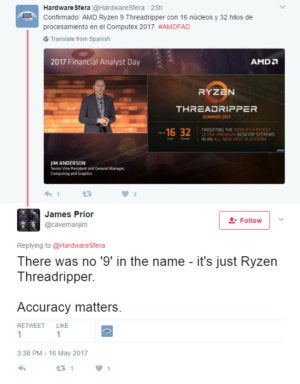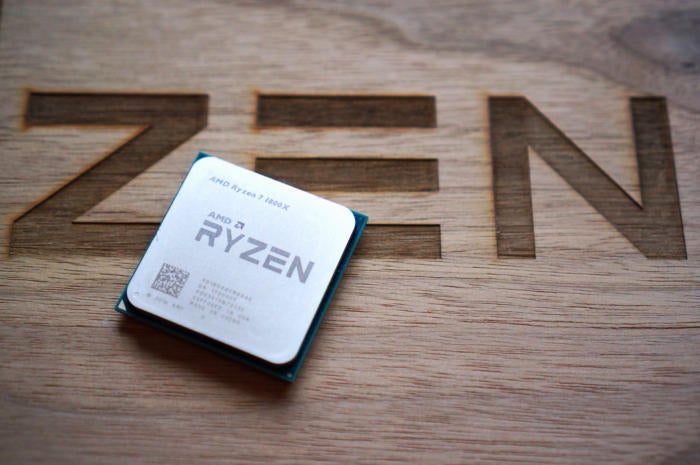
Updated May 30, 2017: AMD revealed more information about Threadripper at Computex, namely its massive socket size and abundant PCI-E lanes. Meanwhile, Intel unveiled its Core i9 X family of chips with up to 18 cores for deep-pocketed enthusiasts. Let the core wars begin!
AMD’s Ryzen Threadripper could very well be the most powerful consumer CPU ever introduced. With 16 cores and 32 threads, it gives the high-performance Intel products currently dominating the same space something to worry about.
The CPU is so new, hard information is scant, but we’ve gathered the most solid stuff here. Check back as we update this story with firmer details.

IDG/Gordon Mah Ung
- The specs we know
- What will it be called?
- What can Ryzen reviews suggest about Threadripper performance?
- What about the 14, 12, and 10-core versions?
- What about the X399 chipset and other specs?
Contents
The specs we know
- Core count: 16
- Thread count: 32
- PCI-E lanes: 64
- Memory: Quad-channel
- Platform: X399
- Can’t be “delided” easily as it uses a solder thermal interface material
- X399 motherboards aren’t compatible with AMD’s Epyc chips
- Release date: Summer of 2017
Yup, that’s it. If you’ve read anything else on Threadripper or “Ryzen 9,” it’s nothing but rumor and speculation at this point. You may say the leaks look good, but we’ll point out that they didn’t even seem to get the CPU name or number of PCI-E lanes right, so you gotta wonder.
What will it be called?
AMD’s Jim Anderson introduced the new CPU as “Ryzen Threadripper” instead of the “Ryzen 9” moniker that had been rumored. Yes, Anderson did speak of “beyond Ryzen 7,” but the lack of a 9 was glaring.
Even more telling, AMD’s James Prior scolded one person on Twitter who used the number, writing: “There was no ‘9’ in the name—it’s just Ryzen Threadripper. Accuracy matters.”

IDG
What can Ryzen reviews suggest about Threadripper performance?
We won’t know the full effect of Ryzen Threadripper’s 16 cores and 32 threads until we test it. Meanwhile, our reviews of Ryzen 7 and Ryzen 5 can give you insights into the strengths and weaknesses of the Ryzen family.
Threadripper could perform quite differently, however, if it does indeed have increased memory bandwidth from the quad-channel controller. We also don’t know the final clock speeds. For the most part, the core performance shouldn’t change much, but stay tuned for our review.
What about the 14, 12, and 10-core versions?
The only Threadripper AMD formally announced was the 16-core part. Yes, we know you’ve seen reports of 14, 12, and 10-core versions. We think that would make a lot of sense, as it matches up with previous CPU introductions.

Gordon Mah Ung
What about the X399 chipset and other specs?
At Computex, AMD revealed that all Threadripper CPUs will feature 64 PCI-E lanes and quad-channel RAM support on the X399 chipset. The socket is yuge.
Churning Internet rumor mills suggest the model numbers will predictably run in the 1900s, with the 10-core being the “Ryzen 9 1955” and the top end 16-core labeled as the “Ryzen 9 1998X.” The same rumor mills put the thermals at 155 watts at the top down to 125 watts at the bottom.
Again though, take Internet rumors with a big grain of salt. Mere hours before Threadripper’s Computex reveal published rumors were still stating the chips would come with 44 PCI-E lanes—20 fewer than reality. The comments from AMD representatives seem to suggest “Ryzen 9” won’t be used in Threadripper part names, either. With E3 just around the corner, we hope to get more official information soon.
What about Core i9?

Intel
AMD isn’t the only company working on a monster CPU for consumers. Intel revealed its Core i9 X family of CPUs at Computex. While Broadwell-E and Haswell-E chips have been nearly identical to the the desktop cores they’re based on, the so-called Skylake-X features support for AVX 512 instructions, which could boost performance in apps that support it.
Core i9 uses a new X299 chipset, and the top-of-the-line Core i9-7900X features 44 PCIe lanes and quad-channel memory support. You need to spend at least $1,000 on a 10-core Core i9 chip to get more than 28 PCI-E lanes, though.
Will you really benefit from that many cores?
 IDG
IDGWith Intel and AMD playing a core war this summer, you’d assume that more cores means better performance. The truth is more nuanced.
How many cores you need really depends on what you do. If you primarily play games, a mega-core PC isn’t likely to yield the performance you’d expect. If, however, you edit video, render 3D, and run other intensive workstation-like tasks, more cores generally means less waiting. Having an embarrassing number of cores can also aid in heavy-duty multitasking. You know, like simultaneously rendering 3D, video, audio, and playing games.
How much will it cost?
The fact that AMD is planning to introduce new CPUs with crazy core and thread counts isn’t the big deal. What’s more important is how much it will cost. Intel’s new Core i9 lineup charges $1,000 for a 10-core chip to $1,700 for a 16-core chip (and $2,000 for the flagship 18-core part).
Will AMD charge in the same ballpark as Intel to raise its profit margins, or continue the hyper-aggressive price war started with its mainstream Ryzen processors, where 8-core processors start at around just $300? No one knows, and even the rumor-mongering press haven’t placed any bets.
